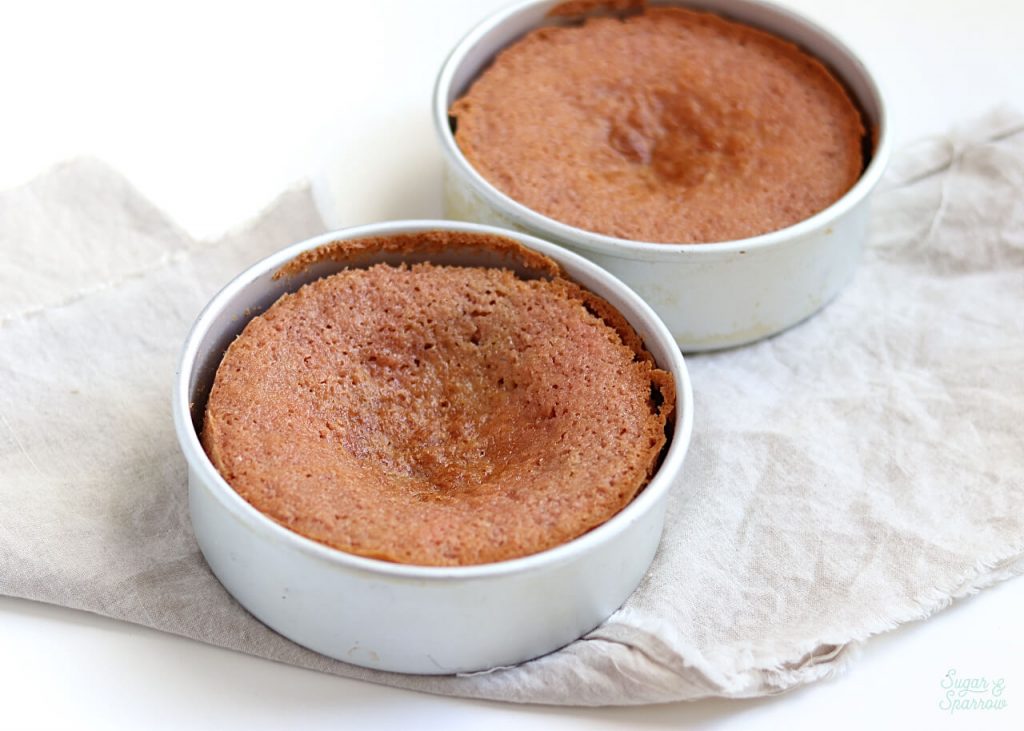In the world of confectionery, details count a lot. Therefore, if something goes wrong, it will be enough for us to remember what we did in order to find the fault. So, if you wonder why the cake sinks in the center, we have the possible causes so you can identify them and avoid them next time.
For now, if you wanted to make a beautiful cake but the cake has only grown around the edges, leaving the center sunken, flip it over to hide the hole, and decorate! Do not worry, because this will not happen to you again after reading this article. From now on, get ready to cook perfect cakes!
Oven temperature is too low or too high
Controlling the temperature throughout the process of making a sponge cake is essential to obtain a good final product. Therefore, the ingredients must be lukewarm, the kitchen needs a constant warm environment and the oven must maintain a suitable and continuous temperature. In this sense, if the temperature of the oven is below what is required, the center of the cake will not cook well. Therefore, the crumb will not develop properly and there will be remains of raw dough when opening the center. Likewise, if the temperature is too high, the cake will brown very quickly without cooking well inside, so it will sink in the center.
To avoid both situations, check the following tips that can help you:
- Preheat the oven. Do it between 10-20 minutes before introducing the preparation.
- Use an oven thermometer. Nothing better than this device to solve the disparity between home ovens. Thus, you will know the precise temperature in your oven.
- Know your oven. If you don’t have a thermometer, practicing will help you recognize the actual temperature of your oven. Rehearse several times and take notes before preparing any recipe for a special occasion.
Open the oven early
As you know, maintaining a constant temperature is essential when preparing a good sponge cake. This explains that famous culinary recommendation that says: never open the oven ahead of time. But why can’t we open it? Because chemical yeast is a fairly delicate product, so if you change the temperature you interrupt its reaction. Baking powder activates as soon as it comes into contact with heat.
If you need to open the oven to check if the cake is done, you must wait at least ¾ of the time stipulated for cooking, that is, 75% of the time required.
Raise or lower the temperature during cooking
For the same reason that you shouldn’t open the oven ahead of time, you shouldn’t raise or lower the temperature of the oven during cooking. That is, changing the temperature during cooking affects the chemical process of the yeast. For this reason, this practice qualifies as one of the causes of why the cake sinks in the middle and only grows on the edges.
Expose the cake to a sudden change in temperature
If the cake grows inside the oven but when you take it out it sinks, it may be because you exposed it to a draft (next to a window, terrace, etc.). For the next time, try to keep the kitchen environment warm (close the windows or the door) and place the cake near a heat source until it cools.
For more tips, don’t miss this other article: “Why does the cake sink when you take it out of the oven”.
Bake with top and bottom heat
The ideal is to cook the cake with heat below during the first few minutes, until it rises, and then put heat on top. If you cook with both at the same time, you can cause the cake not to grow in the center, that is, that it is completely sunken in the middle.
Tip: this recommendation is essential in the case of biscuits prepared with softly beaten eggs.
Take out the cake ahead of time
If you remove the cake before the end of the cooking process, it is logical that it will not cook correctly. So, the center is half raw and, consequently, does not rise and sinks.
If this happens, it could be because you don’t know your oven well and the amount of heat it generates is lower than required by the recipe. Another cause could be that the prescription is wrong. You see, we are adding failures to our list of why the cake sinks in the middle, this will not happen to you anymore!
If your cake has risen correctly but when you cut it you have seen that it is raw, consult this other article: “Why is the cake left raw inside “.
Adding too much chemical yeast
In the kitchen, confectionery is a science, nothing can be left over or lacking. If we refer to yeast, adding more does not mean that we will obtain a more spongy and tall cake, on the contrary, we will weaken its structure. If you overuse chemical yeast, a lot of CO2 escapes in a short time. Therefore, the biscuit accelerates its growth and then collapses, thus being sunken in the center.
Other possible errors related to the use of yeast involved in why the cake sinks in the middle would be the following:
- You did not distribute the chemical yeast well in the preparation while mixing.
- You did not add enough air in the preparation and, at the same time, you used expired chemical yeast.
- You added too much fat and simultaneously used expired baking powder.
Possible solutions to this problem? Use a measuring spoon, change the recipe, sift the baking powder before adding it, make sure that the chemical leavening agent is up to date, distribute the yeast well in the preparation and integrate it correctly.
The dough has excess fat
The fatter the preparation contains, the heavier it is, so if you exceed its proportion, the cake can sink in the center. If you need to remedy it, add a little more yeast. You can also avoid this failure by replacing the grease with a lighter one. It is interesting to mention that in confectionery there are light shakes and heavy shakes, the former do not need fat and the latter do.
Now you know why the cake sinks in the middle when you use too much fat and how to avoid it!
Not mixing the ingredients well
If you do not mix the ingredients well, incorporating them correctly, you will get a cake that does not rise in the center, since the mixture will be uneven. To avoid this problem, you must first sift the dry ingredients and then incorporate them into the liquid ingredients, little by little, until they are completely integrated.
The preparation has more dry ingredients than liquid
A disproportionate preparation in its components can also be the reason why the cake sinks in the middle. If the mixture has more dry ingredients than liquids, we will obtain a cake that does not rise in the center or remains caked. In this case, to avoid repeating this mistake, measure the ingredients well (even better if you weigh them) or change the recipe.
Use a very small mold
Another crucial detail to obtain a good cake is to use the right mold, especially in relation to size. If the pan is too small, the batter will overflow during baking, resulting in a sunken or cracked cake as a result.
When choosing the correct mold, take into account that the dough should cover 2/3 of it, no more and no less. Thus, you complete the preparation with a flourish, ensuring a good final result, that is, an aesthetically pleasing cake.



